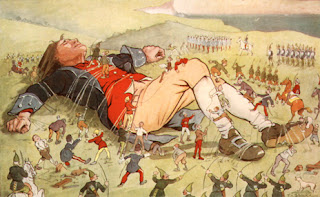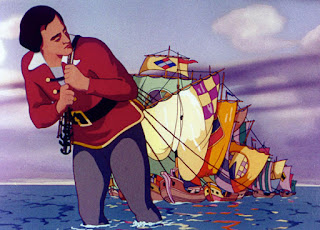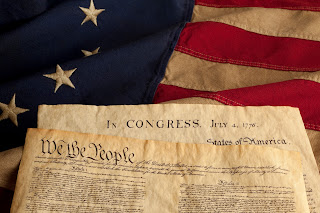The Colonial Period
The first
inhabitants of America were the Indians. They were the only masters of the continent
living in complete freedom and developing customs of their own.
The ‘New
Continent’ became known only after Columbus’s
discovery in 1492. In the 16th
century most European nations began to be interested in the American continent.
In 1607 a
group of some 120 English colonists landed in Virginia and founded Jamestown
which was the first permanent English settlement. In 1620 a
hundred men and women known to history as the ‘Pilgrim Fathers’ came to the Massachusetts shores on board the ‘Mayflower’. They were a group of
Puritans escaping religious persecution in England.
Farther
down the American coast a group of English Catholics colonized Maryland. and
the tolerant and peaceful Quakers, led by William
Penn, gathered in Pennsylvania.
Little by
little thirteen colonies came into existence along the Atlantic coast from
Massachusetts to the Carolinas.
The American Revolution
Since the
beginning the colonies had considered themselves self-governing units within
the British Empire. Britain, however, didn’t want the colonies to govern
themselves and regarded their people as foreigners. She forced them to serve
England’s interests by providing new markets for goods and supplying raw
materials for English industry, compelled them to trade only with the mother
country or its Empire, and imposed arbitrary taxes on glass, lead, paper and
even stamps. Agitation arose against these Impositions and the situation
reached Its climax with the so-called ‘Boston tea-party’. The Bostonians
refused to pay a new tax on tea and threw all the tea the British had just
brought over into the harbour. The other colonies decided a meeting in order to
find a solution. A committee of five members. including Benjamin Franklin and
Thomas Jefferson, drew up a Declaration
of Independence which was adopted on July
4, 1776, the birthday of American Independence.
Having cut
with England and established the United States of America, the new nation had
to struggle for survival. Life was really hard for George Washing-ton, the
Commander-in-Chief, who had only a very small army of farmers. After several
defeats, however, the new nation made alliance with France, and the wheel of
fortune turned. The war ended with the defeat of the English at the battle of Yorktown in 1781. The Treaty of
Versailles ratified the independence of the 13 colonies in 1783.
The Conquest of the West
The new
Federal Government proved to be a good one and was able to assure the nation 70
years of constructive growth.
The U.S.
devoted itself to enlarging its possessions. Louisiana was bought from France,
Florida from Spain and Alaska from the Czar of Russia. A brief and successful
war against Mexico gave the nation vast portions of the South-east including
California, New Mexico and Arizona. The addition of all these territories
extended the U.S. to practically its present size. The vast western deserts and
plains. inhabited by Indians and buffaloes, were an appeal to pioneers.
especially since reports of gold mines in California had spread throughout the
country. starting the famous ‘Gold Rush’.
Pioneers packed their families and furniture In big covered wagons. crossed the
Appalachians and set out to the West. This expansion was marked by a long and
bitter conflict against the Redskin Indians who attempted bravely to defend
their hunting grounds from the Invaders.
The Civil War and the Negro
Problem
Towards the
middle of the 19th century the conflicting interests of the Northern
and Southern States became manifest. The problem of the abolition of slavery
was the main question about which the States were divided. In the North a group
of abolitionists agitated for the immediate stamping out of the institution.
Anti-slavery sentiment, however, was growing not only on moral grounds, but for
political and economic reasons as well. Both free and slave states had so far
been able to balance each other’s influence. But time came when the interests
of the two parts became incompatible, since one was mainly industrial and the
other agrarian. The Northern States, starting up their own factories, needed
protection and claimed high custom duties on foreign imports, while the
Southern States, which shipped raw materials abroad to be turned into
manufactured goods, claimed free trade.
When Abraham Lincoln won the Presidential
Elections in 1861, eleven Southern
States seceded from the union and formed a confederacy. War broke out. The
Confederates were defeated, and Lincoln declared that all the 3,500,000 Negro
slaves of the rebel states should be free. In 1865 the President was
assassinated by a fanatic.
America Becomes a World Power
By the end
of the 19th century the United States had filled up their borders
from the Atlantic to the Pacific Ocean, reaching a population of 76 million.
America had
become a world power. Nevertheless, when World
War I broke out among the European countries, the United States, acting
under the policy of the ‘Monroe Doctrine’ declared its neutrality. The States
entered the war only in 1917, after
a harsh submarine warfare had sunk several American ships. The war ended in 1918. Although America had been a
late-corner to the war and had suffered relatively few losses, its weight in
men, money and supplies had been great; therefore President Wilson could ask for a ‘League of Nations’, embracing victors
and vanquished alike in a democratic brotherhood. This organization would
assure every nation a right peace.
The Atomic Age
Just when
the United States seemed to go through a period of welfare, the sudden crash of
the New York Stock Exchange started the Great
Depression (1929-1933), which
plunged the nation from prosperity to near ruin.
To protect
industry, high custom duties were levied, thus hindering free trade with
foreign countries. Mass production reached a gigantic level and the market was
soon overflowing with goods. Demand was lacking, so production declined,
factories closed and millions of people were out of work. The man capable of
overcoming the crisis was President Franklin
Delano Roosevelt (1933-1945)
with his ‘New Deal’ program.
According to this, the Federal Government favoured reciprocal trade agreements,
repealed prohibition. regulated wages and prices in industry and controlled
farming.
Under
Roosevelt’s leadership, the U.S. entered World
War II in 1941. after Japan had
launched a surprise attack on the naval base of Pearl Harbour. By the middle of 1945 Europe had surrendered, while Japan still had a big army and a
fanatical determination to hold her homeland. To put an end to the war, the
U.S. dropped the first atomic bomb on Hiroshima,
on August 6. Japan surrendered. The
Atomic era had started.
Source: Colle
– Meloni, News. For Juniors, Lattes, an old Italian book 1979.

























